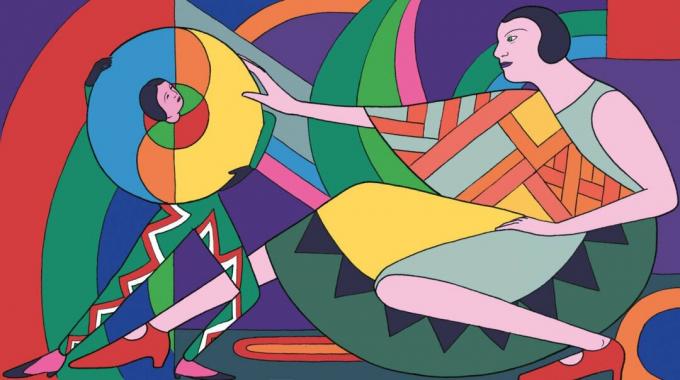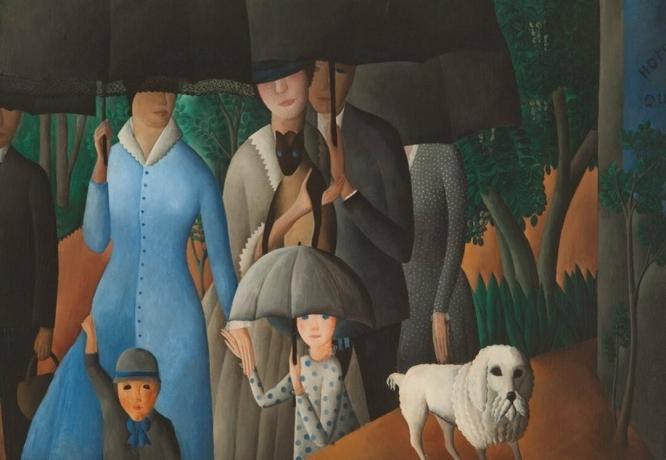The School of Paris and 5 of its most important artists
They are known as “the school of Paris”, but, in reality, they did not form any school. This name includes several artists who created their work in Paris between the wars and who were linked to different movements.. They do not represent any cohesive group, nor did they even follow similar artistic guidelines; Each of them was a free and passionate creator, often devoted to the atmosphere of Parisian bohemianism. In today's article we talk about the famous “Paris school” and 6 of its most important artists.
- We recommend you read: "What was the idea of Time like in the Middle Ages?"
What is the “Paris school”?
The “Paris school” refers to a heterogeneous group of artists (painters, sculptors, designers, etc.) who lived in Paris between the wars, that is, from the First World War to the beginning of the Second. Specifically, the duration of the school is usually limited between the years 1915 and 1940, the years that mark the great tragedy of the wars.
Most of these artists knew each other, as many of them were immigrants who arrived in the French capital at the beginning of the 20th century who helped and supported each other. The years 1905 and 1906 are usually common for their arrivals; These are key years in which the attraction that the cultural effervescence of the city implies does not leave indifferent to a multitude of young Europeans, keenly interested in the most furious current events in the world Of art.
Most of these young people come from Eastern Europe, but will spend most of their lives in France, their host country. But What do all these artists of the Paris school have in common? Nothing, unless it is his love for art, for bohemian life and the coincidence in time and space.. Each one follows their own style and adheres to a movement, so the name school is actually something quite imprecise.
Important artists in interwar Paris
Many of these artists are immortal names. Amedeo Modigliani, Jules Pascin, Chaïm Soutine, Robert and Sonia Delaunay, Olga Sacharoff… and, of course, the brilliant Pablo Picasso, who, curiously, is not usually included in the list, despite the fact that he moved through Paris at the same time as his companions. Perhaps the reason is to be found in the fact that, when others were beginning to make a place for themselves in the world artistic world of the French capital, Picasso, Braque and Matisse were already true monsters in their respective styles.
At the beginning of the 20th century, Paris had emerged as one of the largest creative centers in Europe.. The multitude of galleries and the numerous dealers and collectors attracted aspiring artists, so in the years before the During the First World War, young people from all over the world began to converge in the City of Light with a common desire: to succeed in the world of art.
His work is often relegated to a secondary position. Many of them became famous in the Parisian nightlife and were involved in turbulent episodes related to alcohol, prostitutes and drugs. What is commonly known as “bohemian life”, of course. And interwar Paris had a lot of all that.
Next, we bring you 6 artists who usually add to the list of painters of the Paris school, all of them possessing a very different creative character but they undoubtedly received some mutual influence. Let's see it.
1. Amedeo Modigliani, the “damned”
To honor the truth, the Italian shares the epithet with some other colleagues, including They, Chaïm Soutine and Jules Pascin, authentic enfants terribles of the Parisian bohemia of interwars. However, the nickname suits Modigliani especially well, since it coincides with the French pronunciation of his diminutive, as those close to him knew him: Modì, (maudit, cursed).
Born in Livorno in 1884, Modigliani arrived in Paris in 1906, just as the new century was just beginning, and just as the vibrant city was filled with joy and joie de vivre.. It is the time of the Belle Époque, and the French capital offers an undeniable attraction for young Europeans who want to be someone in the art world.
At first, Modigliani wanted to be a sculptor, but the material was too expensive for his poor pockets. Furthermore, the tuberculosis that he has suffered from a very young age makes him especially susceptible to marble dust. Abandoned the idea of dedicating himself to sculpture, Amedeo decides to follow the path of painting, a facet in which he will begin to stand out at the end of his life, his most productive period. With his unmistakable style, inspired by tribal statuettes and masks (which he contemplated and admired in the Museum of Men), he made a series of excellent portraits, among which those of Jeanne Hébuterne (1898-1920), his last muse and his last great love, stand out.
Beyond his work, Modigliani has entered the popular imagination for his rugged existence, flooded with alcohol, sex and hashish. Her premature death, at only 35 years old, cut short a promising career that was beginning to take off just then.. Jeanne Hébuterne, who was also a painter, committed suicide a day later.

2. Chaïm Soutine, the painter of flesh
We are not referring to “meat” in the lustful sense of the word, but in the most prosaic sense that you can imagine. And, despite having cultivated other genres, Soutine is famous for his still lifes, made up of exclusively for pieces of beef and chicken, which the painter eagerly sought in the markets and butcher shops of Paris.
A good example of his strange fascination with fleshy remains is his painting skinned ox, where the remains of the animal are barely visible among the tangle of loose brushstrokes. By the way, it seems that the painter kept the meat in his studio for so long that it began to smell strongly and alerted the entire neighborhood.
Soutine wanted to be a painter, but his desire, in a Russian Orthodox Jewish family where any representation was prohibited, was difficult to materialize. His father, of course, did not approve of his dream, so young Chaïm had to emigrate to Minsk, at only sixteen years old, to study fine arts and begin to build his career as an artist.
After completing his studies, which also took him to Vilnius, in 1913 he arrived in the effervescent Paris, where he settled in Montparnasse and became friends with the other “damned”, Amedeo Modigliani. Soutine's work, of marked expressionism, became quite famous in the 1920s, and in 1937 we found some of his works at the Exhibition of Independent Artists.
The Nazi invasion of Paris and the Second World War fill him with concern, because let us remember that Soutine is Jewish. Faced with such a threat, the painter decides to run away and leave his host city. He settles in a small town near Tours, where he tries to go unnoticed, but the anguish of the Nazi advance keeps him in suspense and considerably reduces his health. In 1943, he underwent surgery for a perforated ulcer and died during the operation.
3. Robert and Sonia Delaunay, the force of color
The marriage formed by the French Robert Delaunay (1885-1941) and the Ukrainian Sarah Sophie (Sonia) Stern (1885-1979) not only constituted a solid union based on love and absolute complicity, but it also represented one of the most effective tandems in the history of the art. And both of them dedicated themselves completely to art and were two of the great sponsors of abstractionism and the juxtaposition of color..
Robert created the term simultaneism to refer precisely to the fact of applying small juxtaposed tones that, together, will form a harmony of colors for the human eye. This idea is closely related to pure abstractionism (such as that promulgated by Kandinsky), in which colors “dance” across the canvas as if to the beat of perfect music.
Sonia and Robert met through Wilhelm Uhde, in whose gallery she had first exhibited in 1908. The young Ukrainian immigrant had married Uhde of convenience to avoid returning to Russia (remember that, in those years, Ukraine belonged to the Russian Empire). However, her crush on Robert was instantaneous, and in 1910 Sonia divorced Uhde to marry Delaunay..
Sonia Delaunay was not only a painter, but she dedicated herself with equal passion to the design of objects, all made with cheerful colors, and even to the design of advertising posters. The artist was very clear, ever since she saw the work of the Fauvist Matisse, that her vehicle of expression would always be color. Through him, both she and her husband created brilliant, vivid work that profoundly influenced the development of abstract art. The Delaunays are, without a doubt, a key couple in the artistic panorama of the 20th century.

4. Jules Pascin, the other “damned”
Ernest Hemingway portrayed him in one of the chapters of Paris Was a Party, the work he dedicated to the Parisian bohemia of the interwar period. The name of the chapter is quite eloquent: With Pascin in the Dôme. The writer recounts a night at the famous Montparnasse café, where he sees Jules Pascin leaving on the arm of two models.
And the figure of the artist was well known in the Parisian suburbs. Dressed in his inseparable bowler hat, he was known as “The Prince of Montparnasse.”, rivaling his fame with Modigliani himself with whom, by the way, he also shared the epithet: “the damned one.”
Born in Bulgaria and living in Paris since 1905, Pascin, real name Julius Mordecai Pincas, tried very early on gain a place in the artistic world through his magnificent drawings and watercolors, which usually portrayed figures feminine. One of his models was his lover and later his wife, Hermine David, with whom he would share a home and life since 1907.
However, the tormented and restless Pascin felt insecure about his talent. Alcohol was a regular companion of his existence, and depressive states were frequent. On June 2, 1930, on the eve of the opening of a promising solo exhibition, Pascin cut his wrists and hanged himself in his studio in Montmartre..
5. Olga Sacharoff, the Catalan avant-garde
In reality, she was Catalan by adoption, since she was born in Tiflis in 1889. However, the Georgian artist always had a special connection with Catalonia, where she settled permanently after the end of the Civil War, and where she died in 1967. Her love for the land she welcomed is reflected in the numerous paintings she made about Catalan folklore, a representation in the purest naïve style of the traditions of the land..
But before Spain, the painter had settled in Paris, the artistic destination par excellence of the first decades of the 20th century. It is the year 1911, and Olga lands in the French capital after a brief stay in Munich, where she meets German Expressionism and also the photographer Otto Lloyd, who would later become her husband. It is in Paris where Olga comes into contact with the avant-garde, with which she is absolutely fascinated; especially, with synthetic cubism, which she followed stylistically during her early years.
After the outbreak of the First World War, and similar to Robert and Sonia Delaunay, Olga and her husband seek refuge in Spain, which was neutral in the conflict. The crush on Barcelona is instantaneous and, after a second stay in Paris (where they go when the Spanish Civil War breaks out), Olga and Otto return to Barcelona. The couple's house becomes a center for lively gatherings in Barcelona, a place that the artist would never leave again..


